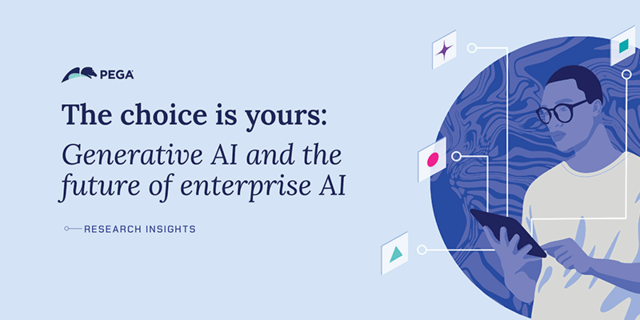As more and more IT and operations leaders face mandates to incorporate AI into their business systems, the question of how to use the technology remains.
Should AI be treated as a way to increase productivity where and when it’s needed, or is there a more holistic way to approach implementation?
In the Q2 2024 Pega Enterprise AI survey, a majority of business leaders indicated that they’re thinking big when it comes to AI: 58% of respondents said they were taking a strategic approach to the technology, with plans to roll out AI as part of a larger digital transformation strategy.
For operations leaders, those larger digital transformation strategies are often done in the service of increased efficiency. Driving efficiency, though, can be a complex effort, which means that those able to implement AI in the service of efficiency – and do it correctly – can benefit from outsized results.
What does this look like in practice? Rather than thinking about AI as a productivity booster to apply in strategic places, business leaders have more to gain by considering how to use AI in concert with process orchestration. With a workflow automation platform as a foundation, AI and automation can be embedded into enterprise processes at scale, driving more than just minor productivity gains.
AI for process orchestration: Leveraging more than one technique for maximum efficiency gain
While we’re still in the early days of AI, it’s become clear that no one AI technique is a silver bullet. Instead, to maximize the potential of AI for workflows, business leaders should be thinking about leveraging multiple techniques across their processes.
More specifically, operations leaders can examine their customer journeys and look for opportunities to:
- Predict issues before they occur
How? Leverage statistical AI algorithms to learn from completed work and drive insights much earlier on in the customer journey around critical issues like when you’re likely to miss an SLA, see work escalated, and more. Then embed those predictions into your workflows to proactively take action to get work back on track. - Make decisions automatically at scale
How? Leverage adaptive learning algorithms in concert with decision modeling to bring rules and AI together and automatically get to the single next best action across your processes. - Automatically categorize work to get it to the right system or team
How? Leverage natural language processing (NLP) and generative AI to understand what a task or case is about and proactively route it to the best place. - Summarize and synthesize information
How? Leverage generative AI to distill documents, text, and data into consumable formats and insights to move processes along.
Citi’s workflow automation and AI success story
Operations leaders at Citi were looking at AI and automation to increase the efficiency of their forbearance program, which had become frustrating for customers.
Rather than looking for places to plug AI in for incremental gains, Citi leaders took a transformational approach: integrating their existing systems with a workflow automation solution and implementing AI and automation at scale.
Their architecture revamp gave them the power to do previously impossible tasks, like facilitating eligibility checks and getting real time updates across multiple applications.
As a result of these efforts, Citi saw significant results, including a 50% reduction in manual work and a major drop in the time needed for customer enrollment – where the process previously took 24 hours, it could now be completed in three seconds!
Moving toward a framework of “AI-led transformation” for business operations
As enterprise leaders think about how to implement AI, it can be useful to think in terms of the transformative, rather than the incremental. How can AI be the impetus for meaningful change? How can the desire to use AI be a forcing function for a needed change in platform or business architecture?
One thing is clear: as the story above illustrates, there are very real gains to be made from the intelligent use of AI in the enterprise. The choice, now, is for operations leaders to make.

